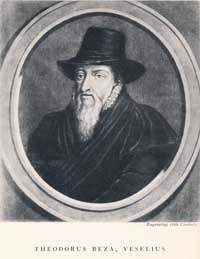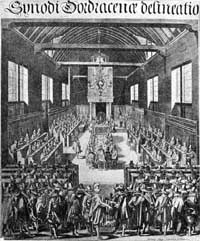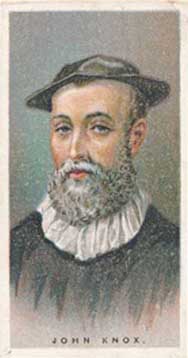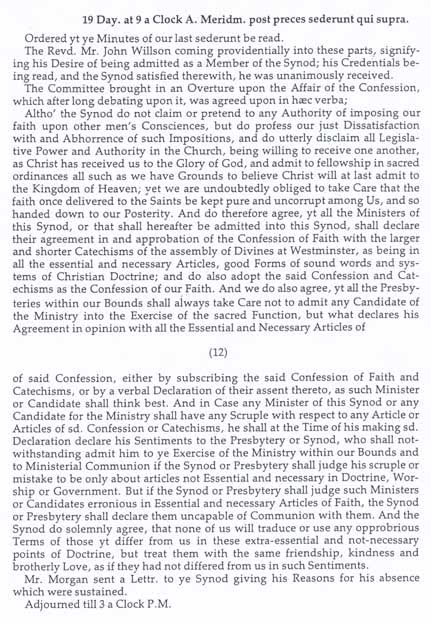Through the sixteenth century a few adventurers were settling in America, and stable institutions came with the seventeenth to attract the attention of European Protestants as they searched for some refuge from the persecuting power which they could not resist in France, could not fight in Spain, played see-saw with in England, overthrew in Germany, and displaced in Holland and Scotland.
France
 If there had been no persecution in Europe, and the Protestant Church could have had freedom from state interference to fight its own battle before the general reason and conscience, the emigrants to America would perhaps have been more like the first settlers in California, or the first inhabitants in a new oil town. As it was, the intellectual conflict and the physical struggle came on together and intensified each other. Huguenot Synods were held in France, and then suppressed, and then re-allowed. The first regularly organized [Protestant] church [in France] was that of Paris, whose people elected John le Macon pastor, and had a board of elders and deacons, in 1555. In 1559 the first National Synod was held, and according to Calvin’s advice a regular system of Appellate Courts was organized. In September, 1561, Theodore Beza, at the head of twelve Protestant ministers made their plea before royalty. It was claimed that there were then more than two thousand churches and stations. The origin of the name “Huguenot” is not known, but it is believed to have been at first a nickname which grew to honor by the character and conduct of its wearers. They had a stormy history. Francis I. was their enemy. Charles IX. (an effeminate boy in the hands of the Medicis) massacred them at St. Bartholomew. Henry IV., at heart a Huguenot, was a brave soldier and a brilliant man, but he turned Catholic for policy’s sake, and yet protected the Huguenots by issuing the Edict of Nantes. then followed Louis XIII. and Richelieu and Louis XIV. and the revocation of the edict of toleration in 1685. These last events came in the seventeenth century. The sixteenth century had demonstrated the advantage of Protestant emigration, and the seventeenth made it compulsory.
If there had been no persecution in Europe, and the Protestant Church could have had freedom from state interference to fight its own battle before the general reason and conscience, the emigrants to America would perhaps have been more like the first settlers in California, or the first inhabitants in a new oil town. As it was, the intellectual conflict and the physical struggle came on together and intensified each other. Huguenot Synods were held in France, and then suppressed, and then re-allowed. The first regularly organized [Protestant] church [in France] was that of Paris, whose people elected John le Macon pastor, and had a board of elders and deacons, in 1555. In 1559 the first National Synod was held, and according to Calvin’s advice a regular system of Appellate Courts was organized. In September, 1561, Theodore Beza, at the head of twelve Protestant ministers made their plea before royalty. It was claimed that there were then more than two thousand churches and stations. The origin of the name “Huguenot” is not known, but it is believed to have been at first a nickname which grew to honor by the character and conduct of its wearers. They had a stormy history. Francis I. was their enemy. Charles IX. (an effeminate boy in the hands of the Medicis) massacred them at St. Bartholomew. Henry IV., at heart a Huguenot, was a brave soldier and a brilliant man, but he turned Catholic for policy’s sake, and yet protected the Huguenots by issuing the Edict of Nantes. then followed Louis XIII. and Richelieu and Louis XIV. and the revocation of the edict of toleration in 1685. These last events came in the seventeenth century. The sixteenth century had demonstrated the advantage of Protestant emigration, and the seventeenth made it compulsory.
 Holland
Holland
In Holland the struggle was between Protestantism and Phillip II. of Spain. These were the days of the Duke of Alva and William the Silent. To save their religion and their homes and drive out the Spaniards, the Dutch cut the dykes and submerged their farms beneath the sea. But through all this suffering they were organizing a people and defending a country that should, in time, give to the world the Protestant and Presbyterian results of the Synod of Dort. That Synod was the nearest to an interdenominational and ecumenical Synod of any held for the forming of Reformation creeds. It was called to decide the controversy between Arminianism and Calvinism; but the selection of the members made it a foregone conclusion that it would condemn Arminius and support the doctrine of Calvin. As a result the “Canons of Dort” are accepted everywhere as good Augustinian theology, and the Reformed Dutch Church of America, both in the earliest time and in the modern, is thoroughly and soundly Presbyterian. The early Dutch immigrants to this country brought with them their names of Consistory, Classis and Synod, with both ministerial and lay delegates, and between them and the Presbyterians there have never been any controversies in either theology or church government.
England
But the main center of American interest in European Presbyterians is found in England. Henry VIII. had married his brother’s widow, Catherine of Aragon. She was a kinswoman of Philip II. of Spain, and Philip and his nation were close friends of the Pope. When, then, the fickle, handsome, headstrong, and licentious Henry wanted to divorce Catherine and marry Anne Boleyn, he easily found his English bishops and universities ready to declare his marriage to his brother’s widow unlawful, but he found it very difficult, for political reasons, to get the Pope so to declare against that marriage that he might thereafter have a non-Catholic wife, and that Mary, his daughter by Catherine, should be an illegitimate child.
Henry cut the knot by declaring himself the head of the Church of England, and the English Church in no possible way subject to Rome. During all this time Protestant doctrines were spreading among the people, and this seemed to open an easy solution. But pure religion in England was not what Henry wanted. He and all the Tudors wanted to have their own way, without interference from parliament or the Church or the people. After the birth of Elizabeth, Anne Boleyn was beheaded to make way for the third of Henry’s six wives. The king now had two female children, one a Romanist and the other a Protestant. When he died, in 1547, he left Edward VI. by Jane Seymour, only nine years old, but an astonishingly precocious Protestant king.
 Under Edward the effort to reform the Church went on vigorously, but everybody was debating, as the chief point of controversy, “What is the scriptural form of government?” John Knox had been a private tutor for Hugh Douglas of Longniddry. The excitement occasioned by the martyrdom of Hamilton and Wishart turned his attention to Protestantism. St. Andrews is a picturesque city, rich in traditions from the Culdee period. At the call of the congregation of that city, Knox began preaching. With the capture of the castle of St. Andrews, Knox was sent a prisoner to the French galleys. After his release he, at one time, became Court preacher for Edward VI.
Under Edward the effort to reform the Church went on vigorously, but everybody was debating, as the chief point of controversy, “What is the scriptural form of government?” John Knox had been a private tutor for Hugh Douglas of Longniddry. The excitement occasioned by the martyrdom of Hamilton and Wishart turned his attention to Protestantism. St. Andrews is a picturesque city, rich in traditions from the Culdee period. At the call of the congregation of that city, Knox began preaching. With the capture of the castle of St. Andrews, Knox was sent a prisoner to the French galleys. After his release he, at one time, became Court preacher for Edward VI.
Romanism, Episcopacy, Presbyterianism, and Independency were now up for discussion. The controversy between Protestantism and Catholicism, under Bloody Mary, made all England a charnel house. Mary [Henry VIII.’s first daughter] was a Tudor and a Spaniard and a Roman Catholic; and the task of bringing back the British Islands under the control of the Pope of Rome was the one religious ambition of her life. How far her relentless persecutions [thus her nickname] were made more relentless by the sadness of her natural disposition, the want of an heir to the throne by her Spanish husband, her residence in England while her alienated husband lived in Spain, and her final loss of Calais, that last remnant of English territory on the Continent, may be hard to decide; but her persecutions filled Geneva, and all European Protestant cities, with English refugees and raised everywhere the question of some land where Protestants could have freedom. Just as she was moving, apparently, toward the destruction of her Protestant sister Elizabeth, Mary died.





